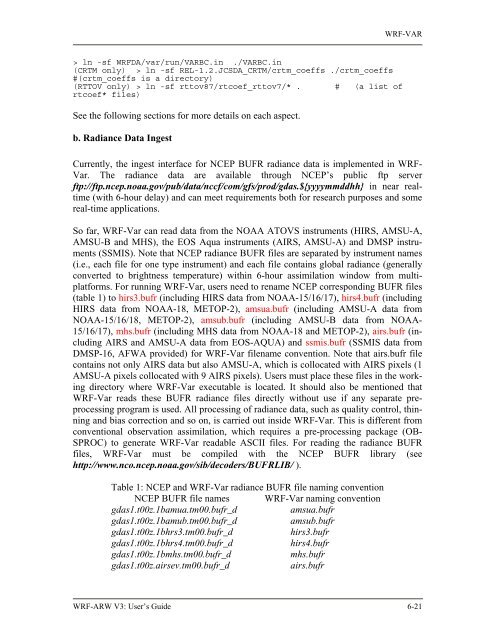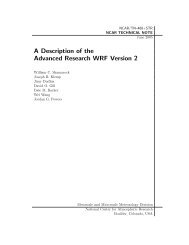You also want an ePaper? Increase the reach of your titles
YUMPU automatically turns print PDFs into web optimized ePapers that Google loves.
<strong>WRF</strong>-VAR<br />
> ln -sf <strong>WRF</strong>DA/var/run/VARBC.in ./VARBC.in<br />
(CRTM only) > ln -sf REL-1.2.JCSDA_CRTM/crtm_coeffs ./crtm_coeffs<br />
#(crtm_coeffs is a directory)<br />
(RTTOV only) > ln -sf rttov87/rtcoef_rttov7/* . # (a list of<br />
rtcoef* files)<br />
See the following sections for more details on each aspect.<br />
b. Radiance Data Ingest<br />
Currently, the ingest interface for NCEP BUFR radiance data is implemented in <strong>WRF</strong>-<br />
Var. The radiance data are available through NCEP’s public ftp server<br />
ftp://ftp.ncep.noaa.gov/pub/data/nccf/com/gfs/prod/gdas.${yyyymmddhh} in near realtime<br />
(with 6-hour delay) and can meet requirements both for research purposes and some<br />
real-time applications.<br />
So far, <strong>WRF</strong>-Var can read data from the NOAA ATOVS instruments (HIRS, AMSU-A,<br />
AMSU-B and MHS), the EOS Aqua instruments (AIRS, AMSU-A) and DMSP instruments<br />
(SSMIS). Note that NCEP radiance BUFR files are separated by instrument names<br />
(i.e., each file for one type instrument) and each file contains global radiance (generally<br />
converted to brightness temperature) within 6-hour assimilation window from multiplatforms.<br />
For running <strong>WRF</strong>-Var, users need to rename NCEP corresponding BUFR files<br />
(table 1) to hirs3.bufr (including HIRS data from NOAA-15/16/17), hirs4.bufr (including<br />
HIRS data from NOAA-18, METOP-2), amsua.bufr (including AMSU-A data from<br />
NOAA-15/16/18, METOP-2), amsub.bufr (including AMSU-B data from NOAA-<br />
15/16/17), mhs.bufr (including MHS data from NOAA-18 and METOP-2), airs.bufr (including<br />
AIRS and AMSU-A data from EOS-AQUA) and ssmis.bufr (SSMIS data from<br />
DMSP-16, AFWA provided) for <strong>WRF</strong>-Var filename convention. Note that airs.bufr file<br />
contains not only AIRS data but also AMSU-A, which is collocated with AIRS pixels (1<br />
AMSU-A pixels collocated with 9 AIRS pixels). Users must place these files in the working<br />
directory where <strong>WRF</strong>-Var executable is located. It should also be mentioned that<br />
<strong>WRF</strong>-Var reads these BUFR radiance files directly without use if any separate preprocessing<br />
program is used. All processing of radiance data, such as quality control, thinning<br />
and bias correction and so on, is carried out inside <strong>WRF</strong>-Var. This is different from<br />
conventional observation assimilation, which requires a pre-processing package (OB-<br />
SPROC) to generate <strong>WRF</strong>-Var readable ASCII files. For reading the radiance BUFR<br />
files, <strong>WRF</strong>-Var must be compiled with the NCEP BUFR library (see<br />
http://www.nco.ncep.noaa.gov/sib/decoders/BUFRLIB/ ).<br />
Table 1: NCEP and <strong>WRF</strong>-Var radiance BUFR file naming convention<br />
NCEP BUFR file names <strong>WRF</strong>-Var naming convention<br />
gdas1.t00z.1bamua.tm00.bufr_d amsua.bufr<br />
gdas1.t00z.1bamub.tm00.bufr_d amsub.bufr<br />
gdas1.t00z.1bhrs3.tm00.bufr_d hirs3.bufr<br />
gdas1.t00z.1bhrs4.tm00.bufr_d hirs4.bufr<br />
gdas1.t00z.1bmhs.tm00.bufr_d mhs.bufr<br />
gdas1.t00z.airsev.tm00.bufr_d airs.bufr<br />
<strong>WRF</strong>-<strong>ARW</strong> V3: User’s <strong>Guide</strong> 6-21

















